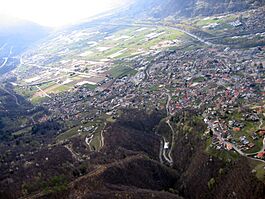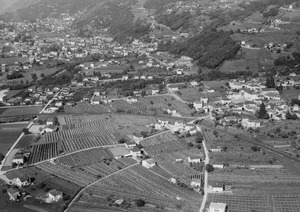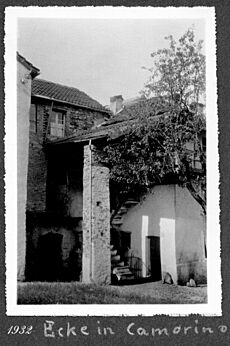Camorino facts for kids
Quick facts for kids
Camorino
|
||
|---|---|---|

Camorino
|
||
|
||
| Country | Switzerland | |
| Canton | Ticino | |
| District | Bellinzona | |
| Area | ||
| • Total | 8.27 km2 (3.19 sq mi) | |
| Elevation | 223 m (732 ft) | |
| Population
(2003)
|
||
| • Total | 2,346 | |
| • Density | 283.68/km2 (734.7/sq mi) | |
| Postal code |
6528
|
|
| Surrounded by | Cadenazzo, Giubiasco, Isone, Medeglia, Pianezzo, Sant'Antonino | |
Camorino was once a municipality (a type of town or local government area) in the Bellinzona district of the canton of Ticino in Switzerland.
On April 2, 2017, Camorino and several other towns like Claro, Giubiasco, and Gorduno joined together to become part of the larger municipality of Bellinzona.
Contents
History of Camorino
For a very long time, people from a nearby place called Isone would travel over the Tiglio mountain pass to reach the Camorino area. They owned vineyards (places where grapes are grown) and farmland there. Over many years, some of these people decided to stay and build a village.
Camorino was first mentioned in old records in 1237. At that time, it was part of the lands belonging to the S. Pietro church in Bellinzona. A church was noted in the village in 1237 and again in 1285, but we don't have any parts of those old buildings left today. The church you can see now, called San Martino, was built in 1553 and was fully updated in 1888. In 1583, the village church became separate from the main church in Bellinzona, and it was officially recognized as its own parish (a church district) in 1591.
In 1853, a line of defenses was built between Sementina and Camorino. This project was started to help people from Ticino who had been forced to leave the Kingdom of Lombardy–Venetia by giving them jobs. Part of these defenses are the Fortini della fame, which means "Forts of Hunger." These are five round towers with narrow openings for arrows or guns in their upper parts.
Camorino used to be a village mainly focused on farming. People grew grapes and strawberries, and raised animals. There were also some small businesses like crafts, trading, and light industry, such as making knitwear and pasta, and running a mill. Because there weren't many jobs, some people moved away to America.
As the nearby cities of Giubiasco and Bellinzona grew, so did Camorino's population. Today, Camorino is mostly a place where people live and then travel to other towns for work. It doesn't have large factories or much farming anymore.
What is Camorino Like? (Geography)
Camorino covers an area of about 8.28 square kilometers (about 3.2 square miles).
- About 23% of this land is used for farming.
- A large part, about 67%, is covered by forests.
- Around 12.7% of the land has buildings or roads on it.
- A small amount, less than 1%, is rivers or lakes.
- The rest is land that isn't used for anything specific.
Most of the built-up area is made up of houses and other buildings, along with roads and other ways to get around. The forests are mostly dense woods. Camorino is located in the Bellinzona district and is like a neighborhood or smaller town connected to Bellinzona. Important roads and train lines that lead into Bellinzona pass through the village.
Camorino's Coat of Arms
A coat of arms is like a special symbol or logo for a town or family. Camorino's coat of arms has a red background. At the bottom, there's a wavy silver (white) section with two wavy blue lines. On top of all this is a golden mill wheel.
The mill wheel on the coat of arms represents a special mill called the Maglio. This mill, along with one other house, was the only thing that survived a big landslide that destroyed the rest of the village a long time ago.
People of Camorino (Demographics)
Camorino has a population of about 2,706 people (as of 2008). About 16% of the people living there are from other countries. Over ten years (from 1997 to 2007), the population grew by about 17.7%.
Most people in Camorino speak Italian, which is about 90% of the population. The next most common language is German, spoken by about 5% of the people, followed by French.
In 2008, there were slightly more men (50.4%) than women (49.6%) living in Camorino. The age groups in Camorino (as of 2009) show that:
- About 11% of the population are children aged 0-9.
- About 10% are teenagers aged 10-19.
- Around 11.7% are young adults aged 20-29.
- The largest groups are adults aged 30-39 (14.2%) and 40-49 (17.8%).
- About 13.7% are aged 50-59.
- Older adults (60-69) make up about 10.6%, while those 70-79 are 6.6%, and people over 80 are about 4.3%.
Most homes in Camorino are single-family houses. In 2000, there were 934 households, with about 2.4 people living in each.
Here's how the population of Camorino has changed over time:
| year | population |
|---|---|
| 1591 | 400 |
| 1698 | 211 |
| 1784 | 300 |
| 1850 | 321 |
| 1880 | 483 |
| 1900 | 405 |
| 1950 | 702 |
| 1980 | 1,476 |
| 1990 | 1,709 |
| 2000 | 2,210 |
Important Historical Sites
The old fortifications from the 1800s and the Fortini Della Fame (Forts of Hunger) are considered very important historical sites in Switzerland. They are listed as heritage sites of national significance.
Camorino's Economy
In 2007, the unemployment rate in Camorino was about 4.7%. This means that about 4.7% of people who wanted to work couldn't find a job.
The economy is divided into three main parts:
- Primary sector: This involves working with natural resources, like farming. In 2005, about 71 people worked in this area, mostly in farming.
- Secondary sector: This involves making things, like in factories. About 217 people worked in this sector.
- Tertiary sector: This involves providing services, like shops, offices, or hotels. This was the largest sector, with 666 people working in it.
Many people who live in Camorino travel to other towns for work. In 2000, 747 people left Camorino to work elsewhere, while 660 people came into Camorino for their jobs. This means more people leave Camorino for work than come in.
Most people (about 67.8%) use a private car to get to work, while a smaller number (8%) use public transportation like buses or trains. As of 2009, there was one hotel in Camorino.
Religion in Camorino
According to a census in 2000, most people in Camorino (about 80%) were Roman Catholic. A smaller group (about 5%) belonged to the Swiss Reformed Church. Some people belonged to other churches, and a few did not state their religion.
Education in Camorino
Switzerland is known for having a well-educated population. In Camorino, about 70% of adults aged 25-64 have completed either high school or even higher education, like university.
In 2009, there were 469 students in Camorino. The education system in Ticino canton includes:
- Kindergarten: Up to three years of non-required schooling for young children. In Camorino, 73 children were in kindergarten.
- Primary School: This program lasts for five years. In Camorino, 160 students attended regular primary schools.
- Lower Secondary School: After primary school, students can choose different paths. Some go to a two-year middle school followed by a two-year program to prepare for a job. Others go to a four-year program to get ready for higher education.
- Upper Secondary School: This level prepares students for a trade job or for university. Students can attend school while doing an internship (learning on the job) or go to school full-time.
- Professional Programs: These programs last three years and prepare students for jobs in fields like engineering, nursing, or business.
In 2000, 246 students from Camorino went to schools outside the municipality.
See also
 In Spanish: Camorino para niños
In Spanish: Camorino para niños







